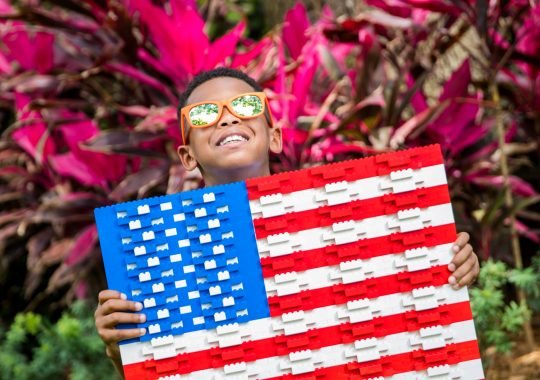|
Getting your Trinity Audio player ready...
|
The minimalist mantra says that a man’s enemies are not his possessions but an excess of them. This holds even during vacations – most of us can relate to packing extra clothes, toiletries, and whatnot, only to be guilt-ridden on the way back as a third of those “extras” return untouched.
Are your resolutions for packing light also failing? What if you could comfortably travel for an entire week with a single backpack? Not only that but that backpack could easily fit into your flight’s overhead bin. If you feel like it all sounds too good in theory, this article will show you how easy it is in practice.

Instead of packing light, look at it as a way of traveling smart. After all, learning the art of traveling with less will save you checked baggage fees, time otherwise spent on the luggage carousel, and the hassles involved in hopping from one flight to another. Here’s all you need to know about planning a 7-day trip with a single carry-on travel bag.
Start with the Right Backpack Selection
Though suitcases can run on wheels, a backpack is still the better option because it can be carried. In comparison, a backpack travel bag is much lighter than a suitcase (which in itself weighs a lot). After adding all the travel essentials, sometimes even dragging a suitcase becomes challenging. Plus, you must be careful about running over people’s feet!
However, most travelers choose a massive backpack, which they overpack and carry around with great difficulty. It is human nature to want to fill extra space with “just-in-case” items. To avoid packing more than you need for a week’s trip, choose the right backpack size.
According to Tortuga, a 40-liter travel backpack should be sufficient for a week-long trip, whereas a 30-liter backpack works best for shorter weekend trips. When filled with the right essentials and organized properly, the bags won’t cross the overhead bin limit.
A good-quality backpack may lean a bit on the costlier side, but it will be worth it. Cheaper variations are usually made using unreliable materials – poor-quality shoulder straps and padding. The difference between a premium and cheap-end backpack becomes apparent within a few days.
In case you feel the need to have an extra bag, it’s best to choose a daypack which is ideal for essentials like passports, a travel-size bottle, a wallet, and other important documents. Once zipped, try to fit the daypack inside the backpack itself. This extra bag will come in handy while exploring the different tourist spots within the destination.
Get to Know the Destination(s) Intimately
Before you can have a clear idea of what to pack, run preliminary research on the destination, weather, best tourist spots, activities to do, etc. Start with the weather – use apps and weather forecasts to understand the weather on the days you visit the place. For example – if the weather is expected to be rainy with mild thunderstorms, you can eliminate a pair of shorts and pack a raincoat instead.
Similarly, plan your activities and itinerary so you don’t end up missing essential items or carrying extras. For example – if you’re planning to spend three days on different beaches, it’s best to pack more beach-friendly outfits than regular jeans and skirts.
Select the Most Important Items to Carry
Once you have chosen your ideal backpack, researched the destination (its weather), and have a somewhat clear idea of the week’s activities, it’s time to lay out the necessary items to carry. First, categorize the different items and lay them on the bed or floor. These may include –
Clothes
The first tip for carrying clothes is to choose versatile pieces that easily mix and match with the others. For instance – if you choose bold colors and prints for top wear, keep the bottom-wear neutral with colors like navy, beige, khaki, or black.
Also, ensure the pieces are made using synthetic fabrics like polyester (that do not crinkle easily like cotton). You can also keep your week’s activities in mind before picking out the outfits – jeans for exploring the city, a fancy dress for an evening event, and so on.
For men, a week-long trip would typically include two pairs of jeans and t-shirts, a pair of shorts, one long-sleeved shirt, a jacket or cardigan (in case of winter), three undergarments, and two to three pairs of socks.
Women’s basic clothing would include two pairs of jeans (one in a darker shade and the other in a lighter shade), three short-sleeved tops, two lightweight dresses, two pairs of shorts, a cardigan, and a bunch of undergarments. Another pro tip would be to wear all the bulkiest items on the flight.
Accessories
Many people enjoy color-coding their accessories and footwear with their outfits. It is recommended that you accessorize using neutral colors to save packing space. For instance – a comfortable pair of khaki sandals along with running shoes should be enough for women (replace the shoes with hiking boots depending on your itinerary).
Men can also pack lightweight sandals along with canvas shoes or hiking boots. As for the accessories, keep it minimal and choose timeless pieces like a watch, a pearl necklace, sunglasses, a hat or cap, and a scarf. Also, wear the bulkiest items on the flight if possible.
Gadgets
Two gadgets that most people carry but seldom use are their high-end DSLR cameras and laptops. Smartphone cameras are pretty advanced these days, so unless the purpose of the trip is photography, let the DSLR stay at home.
Likewise, if you wish to get some work done during your trip, carry a laptop, or it is best to leave it behind. You may carry a tablet if you wish to read or do work, but only if it’s necessary and the smartphone is unsuitable for the task.
Medical Supplies and Toiletries
It’s not uncommon to find people carrying three kinds of bath gels, a horde of makeup wipes, and two different fragrances of shampoos. These are all basic items easily available in any city. If it’s about the specific brand, opt for travel-size options that will last you for a week.
As for medical supplies, do carry prescription drugs as they may not be easily available everywhere. Other than that, you can keep medications for common illnesses like seasickness, nausea, stomach upset, or cold and cough.
Snacks and Entertainment for the Journey
Some people go as far as carrying cards and board games for entertainment during breaks in the journey. This is not needed because smartphones cover all entertainment needs. You can easily download fun games before the trip and play them on the way.
If you must carry snacks, choose healthy and filling options like protein bars, nuts and crackers, etc. It is best to choose your favorite snacking options (and healthier versions of them).
While choosing what to pack, be willing to ruthlessly eliminate the unnecessary. For instance – do not pack that trendy shirt in anticipation of squeezing it into your trip’s fashion routine. If you’re not 100% sure about an item, let it go.
Pack the Items the Right Way
Once you’ve curated your travel essentials list, it’s time to organize them in a manner that they fit comfortably into a carry-on backpack. Here are some tips for that –
Roll Your Clothes
If you’re accustomed to folding your clothes flatly into a suitcase, the same method won’t work for a backpack. The way to save space is to use the army roll or Ranger rolling technique used by the US military servicemen.
This technique works for all kinds of garments (except for asymmetrical dresses), even trousers and jeans, and will not wrinkle your clothes. Create the bag’s base with rolled garments and place the delicate gadgets on top of this base. With the gadgets at the center of the bag, place more rolled garments on top.
Any gaps can be used to stuff small essentials like socks and underwear. You can also cushion the bag’s back with rolled t-shirts to avoid discomfort while carrying.
Use Packing Organizers
Several kinds of packing organizers, including Ziploc bags, packing cubes, etc., are available to help you use your backpack space efficiently. For instance – compression bags can be compressed to remove excess air (which maximizes space).
Use multiple compression bags to store different categories of garments – shirts, bottoms, jackets, etc. These bags not only help in the proper organization but also make the repacking process during the trip a whole lot easier.
Additional Tips to Get You Going
Up until now, we’ve discussed the basics of smart packing for a 7-day trip. Now, let’s jump into some additional tried-and-tested tips –
1. Be Okay with the Fact of Reusing Outfits
If you’re packing light and smart, you will have to repurpose your outfits at least every two days. This is not essentially bad because it allows your creative side to shine through, and if done right, nobody will even notice.
2. Consider Sharing Stuff When Traveling in a Group
If you’re traveling with other family members or friends, discuss with them about sharing certain items (except hygiene-related products). You can also barter the essentials so that one person carries the shampoo for the entire group, whereas the other packs the toothpaste. This way, all can eliminate a few items from their luggage.
3. Remember to Separate Needs from Wants
No amount of smart organization and sharing strategies will work if you’re unwilling to leave behind some unnecessary items. This leads us back to the basic idea of deduction – separate your needs from wants and eliminate items accordingly. Remember that the essence of the trip is to explore, enjoy, and create lasting memories.
Things You Can Do Without
When it comes to traveling smart, the key is to strike a balance. On one end of the scale are those bent in half, painfully dragging around a second or third suitcase. On the other extreme are folks with a small duffel bag always annoying the others with their constant borrowing.
Seasoned travelers know how to hone down their luggage’s contents to make their travel experience comfortable and enjoyable. If you wish to belong to this rare group, you must learn to let go of a few things, including –
The Just-in-Case Items
Just like clutter in the home increases with ‘just-in-case’ items, so does clutter in the luggage. If you’re not sure about when and where to use a particular item, it is best left behind. In case a sudden need does arise, all won’t be lost unless you’re planning an excursion to the moon – the destination will have several shops and outlets supplying what you need.
Excess of Anything
Every traveler has their personal faults in the area of excess packing. Some pack too many clothes, others can’t resist the coolest gadgets, whereas others hoard toiletries. Identify your weakness and remove the excess. For example – In lieu of three towels, carry a large chamois towel which is super-absorbent and dries easily.
Physical Books
Some travelers love to accompany their wanderlust with a passion for reading, while others love to journal daily. But, physical books can easily add to the backpack’s weight and reduce space. If you must, carry a tablet or e-reader and record your personal thoughts in a virtual diary (which can be penned down after you’re back from the trip).
Ready to Hit the Roads?
According to Fortune Business Insights, the global travel backpack market was valued at $15.9 billion in 2022 and is expected to reach a whopping $31.38 billion by 2030. More people are realizing the value of ditching the excess and traveling with only the essentials.
They are replacing bulky suitcases with ergonomic travel backpacks that meet the needs of their trip. For the ideal backpack, choose a supplier renowned for using durable and high-quality materials. You can use zipper rings or small PIN locks to keep the bag’s contents safe.
Place functionality over aesthetics – choose a darker shade bag that does not show dirt easily, ensure you’re comfortable with the hip belt, shoulder straps, and padding, and check for adequate compartments and easy-to-find pockets. Then, get ready to travel smart and enjoy memorable moments with friends, family, and the destination’s locals!



